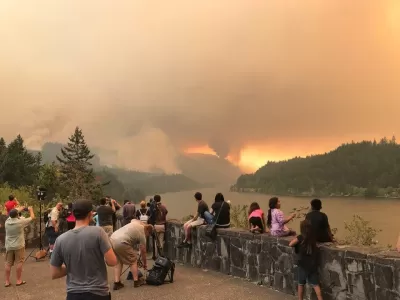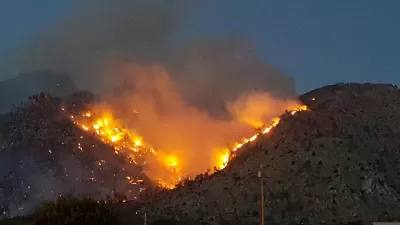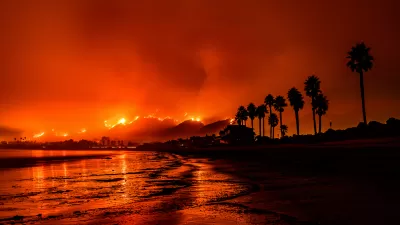Two new books chronicle the origin of U.S. policy on wildfire, the damage that policy has done, and why it’s unlikely to change any time soon.

In The New York Times, Brendan Koerner reviews two recently released nonfiction books that chronicle the markedly increased number of wildfires in the U.S., the causes of that increase, and the way that the current policy of the federal Fire Service is interfering with the natural ecology of fire-prone areas.
Koerner traces that policy to a fire known as the Big Blowup, which enveloped parts of Idaho in 1910. Seventy-eight firefighters died; Koerner writes, “Staggered by the scale of the destruction and the vitriol of the resulting newspaper headlines, the five-year-old United States Forest Service felt compelled to declare an all-out war on wildfires.”
The unintended consequences of the war of wildfires have been bigger, more intense fires, and higher costs of fighting them.
“[L]ike many well-intentioned policies that arise in the wake of tragedy, the war on wildfires has proved to be self-defeating. As detailed in Michael Kodas’s bracing 'Megafire' and Edward Struzik’s drier 'Firestorm,' today’s forests are often clogged with desiccated vegetation because—unlike in countless millenniums past—they are seldom cleansed by naturally occurring blazes. With such an abundance of fuel to feast on, wildfires like those currently raging in California have become increasingly ruinous and intense. Ten million acres of the United States burned in 2015, over three times more than the annual average throughout the 1970s. And the Forest Service now spends more than half its budget fighting fires, compared with just 16 percent in 1995.”
Neither author is the first to bring up the counter-productivity of wildfire policy in the U.S. in the last century, but the issue persists because possibly the most significant contributor (another being climate change) to the increased damage caused by wildfire is the millions of people settling on land at risk of burning.
And changing the policy—by allowing some fires to burn, and initiating controlled burns to clear out the brush that ultimately becomes fuel for uncontrolled fires—is both counterintuitive to many and wildly unpopular with those that live adjacent to those burns.
“There is no easy way,” Koerner writes, “to convince the owners of those homes that a fire they can glimpse from their bedrooms should be allowed to burn for long-term strategic purposes.”
Damage caused by these fires reaches well beyond the homes they consume; they also release greenhouse gasses that perpetuate climate change and burn hazardous substances leftover from mining operations across the West, according to the books reviewed.
"Megafire," at least, ends with optimism, but Koerner finds it “unintentionally” downbeat.
“[Kodas] expresses hope that these deaths will begin to awaken people to the fact that, ever since the Big Blowup, wildfire policy has been guided by a 'tangled tree of legends' rather than solid science. But that sentiment struck me as depressingly naïve. In recent years, high-profile tragedies have rarely transformed public discourse; instead, they’ve tended to inspire people to cling ever more fervently to their customary beliefs, as if it would be dishonorable to admit the existence of complexity and nuance. Such is life in the era of the knee-jerk double down, which is why the era of megafires is likely here to stay.”
FULL STORY: Are the American West’s Wildfires Inevitable?

Alabama: Trump Terminates Settlements for Black Communities Harmed By Raw Sewage
Trump deemed the landmark civil rights agreement “illegal DEI and environmental justice policy.”

Planetizen Federal Action Tracker
A weekly monitor of how Trump’s orders and actions are impacting planners and planning in America.

Why Should We Subsidize Public Transportation?
Many public transit agencies face financial stress due to rising costs, declining fare revenue, and declining subsidies. Transit advocates must provide a strong business case for increasing public transit funding.

Understanding Road Diets
An explainer from Momentum highlights the advantages of reducing vehicle lanes in favor of more bike, transit, and pedestrian infrastructure.

New California Law Regulates Warehouse Pollution
A new law tightens building and emissions regulations for large distribution warehouses to mitigate air pollution and traffic in surrounding communities.

Phoenix Announces Opening Date for Light Rail Extension
The South Central extension will connect South Phoenix to downtown and other major hubs starting on June 7.
Urban Design for Planners 1: Software Tools
This six-course series explores essential urban design concepts using open source software and equips planners with the tools they need to participate fully in the urban design process.
Planning for Universal Design
Learn the tools for implementing Universal Design in planning regulations.
Caltrans
Smith Gee Studio
Institute for Housing and Urban Development Studies (IHS)
City of Grandview
Harvard GSD Executive Education
Toledo-Lucas County Plan Commissions
Salt Lake City
NYU Wagner Graduate School of Public Service





























